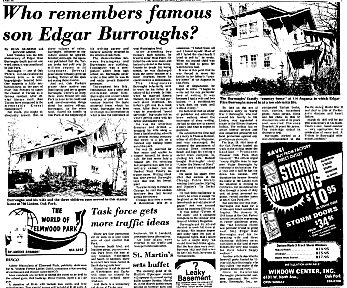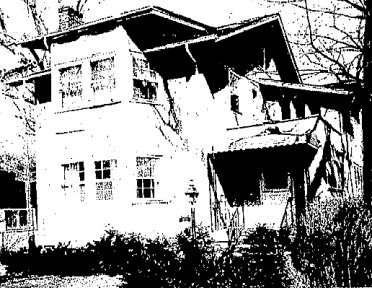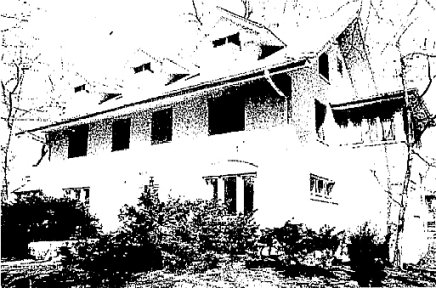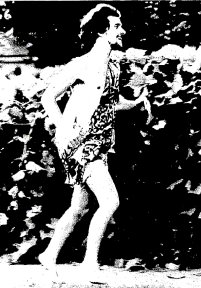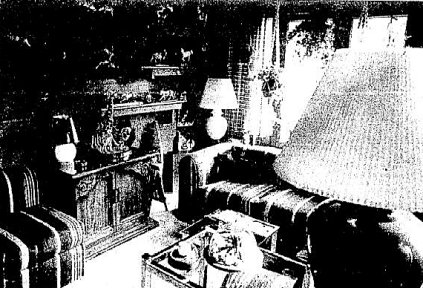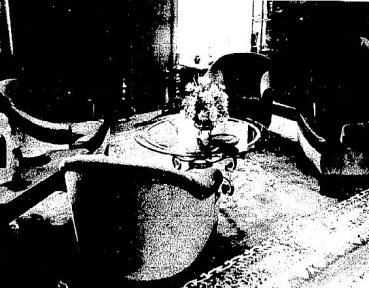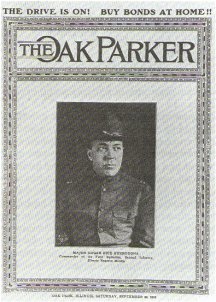An advertisement offering "Two houses and a vacant lot" for
sale ran in an Oak Park newspaper, March 16, 1918.
It was placed by Edgar Rice Burroughs, creator of the famed Tarzan
of the Apes. The home, still in splendid shape, is at 700 Linden ave.
"With eight bedrooms, three baths, four toilets, a sun parlor and a
glazed sleeping porch," it was offered at- $30,000, which might just bringa
bemusedsmile to the new owners who recently moved in. Burroughs had previously
been in residence at 414 Augusta,and this house and a vacant lot on Ridgeland
just north of Augusta were offered also.
It was while he was in residence at the Linden house that Burroughs
published his blockbuster, "Tarzan of the Apes." He had come to Oak Park
in 1913 with wife and three children. It was that year that he broke all
records for production: 413,000 words!
By the time he decided to go to California (he finally got there in
1919) to get away from what he called our "abominable climate," he had
become established as the country's leading producer of pulp fiction. The
movies, radio, television, sweat shirts, Johnnyeismuller and yell contests
and all the rest were ahead of him. When he died in 1950 he had put together
a fortune of $15 million.
But after he left Oak Park for the heaven of California all was not
sweetness and light. Lumps began to develop in the mashed potatoes. Listen
to this litany of beefs in a March, 1919 letter to an old pal back East:
"My secretary and her husband threw up the sponge last week and departed
hence for Illinois. I am now my own secretary, hog expert and goat
impresario. Also both my goat herders quit Saturday, a coyote killed a
kid Saturday, three other kids died; I fired the ranch cook, it rained
all over my freshly mown hay and the starter on the Chandler (early make
of car) won't work.
"Otherwise we are having a heluva nice time. (I just glanced out the
front window to discover that the pole on the rake is broken and that two
men have stopped work to look at it, leaving them and the tractor idle).
But somehow I can't help liking it -- I never loved any place in my life
as I do this and if anything happens that I don't make a go of it I believe
it would about break my heart."
The mind that had created fantastic worlds in outer space and the jungle
was now grubbing with petty details of animal breeding. A herd of prize
Angora goats had come with the property. Tarzana was a magnificent spread
of 540 acres in the San Fernando valley. About the house on a small knoll
were plants and shrubs from Asia and Africa no'ddingwelcome to the new
owner.
Burroughs is the subject of a massive biography just acquired by the
Oak Park public library. It is published by Brigham University Press; 820
pages, 270 photos, $14.95 or about $2.50 a pound.
The author is Irwin Porges, ardent fan and admirer. Porges and wife,
a trained researcher, spent four years sifting through a warehouse of correspondence
and memorabilia. ERB was a packrat who never threw out anything.. Thus
we have preserved for us such unprofound trivia as this letter, written
at age seven to his father, away on business:
"How are you. I miss you very much. We are all well."
But aside from scores of pages of such kid stuff there is much gold
in this monster of a book.The rags-toriches-American-will-to-win-Horatio-AIger
syndrome is at work here. Before he hit the Tarzan button at age 35, our
hero had held 18 jobs in 15 years including door-to-door selling and patent
medicine peddling. After his success, he prepared his autobiography and
jotted down these stark notes. They reveal much about the aimlessness of
his many early "careers."
"I get a job as timekeeper on a construction job;dizzy heights... I
sell Stoddard lectures . . . candy . . . light bulbs... I am a Flop...
get job as expert accountant . . . make good .... go to Sears . . . Joan
born (first child) ... go into business with Dentzer.(pots and pans, door
to door). . . Fail ... get job with Stace (peddling a patent medicine,
supposedly cure for alcoholism) . . . Stace-Burroughs (correspondence course
in how to succeed at selling) . . . Flop. . . headaches for years -- no
vacation -- lunches (during one period he said his lunches for weeks consisted
of three cents worth of ginger snaps) .
.
"Sell pencil sharpeners ... am just about ready to give up ... start
writing a "Princess of Mars" ... in corset jobbers office at Market and
Monroe . . . Champlain Yardley co. (they made scratch pads) . . . one half
of story accepted . . . My first check (it was for $400). . . write "Outlaw
of Torn". . . rejected . . . great poverty . .. pawning watch ... get job
with System (advice to businessmen) . . . Jack born (second child) . .
. give up my job and decide to depend solely on writing . . . everyone
thinks I am crazy including myself."
Anyone with that talent for self-assessment in the face of adversity
can't be all bad. Of course, once he got started he never lookedback.
Editors of Ballantine books, in a recent reprint of the Tarzan series,
said, "In the 38 years until his death in 1959 Burroughs produced 91 books
and a host of short stories and articles. No one knows how many copies
of ERB books have been published throughout the world. It is conservative
to say, however, that of the translations into 32 languages and Braille
the number must be in the hundreds of millions."
ERB Inc., a corporation set up as far back as 1922 by the canny Burroughs,
still multiplies and increases the fortune left behind by the founder.
Television, movies, endless reprints and tie-ins have resulted in a pop
literature monolith that is a phenomenon of our time. And it goes on and
on.
Academicians, scholars of the classics and the more disciplined types
of literature are advised to save their sneers. Here was a strange, curious
and altogether remarkable man. His life,times and works are worth some
serious attention.
His rich but overloaded biography is at the Oak Park library,where readers
service department is doing a good job of keeping up with current events.
If you can reserve it off the waiting list best take along a small boy
and a little red wagon as the bookweighs six pounds.

![]()
